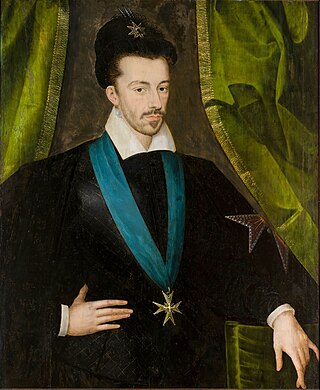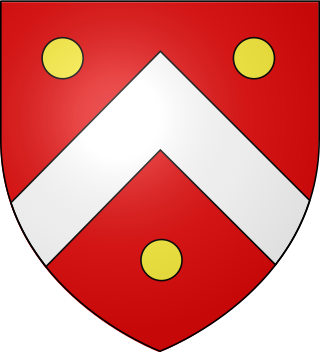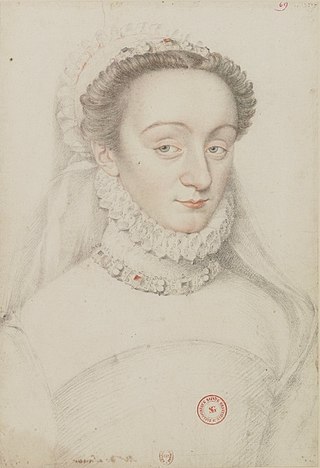Related Research Articles

Charles IX was King of France from 1560 until his death in 1574. He ascended the French throne upon the death of his brother Francis II in 1560, and as such was the penultimate monarch of the House of Valois.

Henry III was King of France from 1574 until his assassination in 1589, as well as King of Poland and Grand Duke of Lithuania from 1573 to 1575.

Henry I, Prince of Joinville, Duke of Guise, Count of Eu, sometimes called Le Balafré ('Scarface'), was the eldest son of Francis, Duke of Guise, and Anna d'Este. His maternal grandparents were Ercole II d'Este, Duke of Ferrara, and Renée of France. Through his maternal grandfather, he was a descendant of Lucrezia Borgia and Pope Alexander VI.

The House of Rohan is a Breton family of viscounts, later dukes and princes in the French nobility, coming from the locality of Rohan in Brittany. Their line descends from the viscounts of Porhoët and is said to trace back to the legendary Conan Meriadoc. Through the Porhoët family, the Rohans are related to the Dukes of Brittany, with whom the family intermingled again after its inception. During the Middle Ages, it was one of the most powerful families in the Duchy of Brittany. The Rohans developed ties with the French and English royal houses as well, and they played an important role in French and European history.

Arnaud d'Ossat was a French diplomat and writer and a Cardinal of the Roman Catholic Church, whose personal tact and diplomatic skill steered the perilous course of French diplomacy with the papacy in the reign of Henry IV of France.

Samblançay, or Semblançay, is a French noble family of Touraine, originally from the merchant class and taking their name from a village in Indre-et-Loire.
The Secretary of State of the Maison du Roi was the secretary of state in France during the Ancien Régime and Bourbon Restoration in charge of the Département de la Maison du Roi. The exact composition of the ministry and the secretary's duties changed several times over the Early Modern period, but in general, the Département de la Maison du Roi oversaw four main areas: the "Maison du Roi", the "Bâtiments du Roi", the General Affairs of the Clergy, Affairs of the RPR, and the administration of the capital city of Paris and the provinces. The post later reappeared as the Minister for the Maison du Roi.

The Superintendent of Finances was the name of the minister in charge of finances in France from 1561 to 1661. The position was abolished in 1661 with the downfall of Nicolas Fouquet, and a new position was created, the Controller-General of Finances.

The Gardes du Corps du Roi was the senior formation of the King of France's household cavalry within the maison militaire du roi de France.

The Metropolitan Archdiocese of Montpellier (–Lodève–Béziers–Agde–Saint-Pons-de-Thomières) is a Latin archdiocese of the Catholic Church in south-western France. It was probably created in the 3rd century AD. The current metropolitan archbishop is Pierre-Marie Carré; the immediate past Archbishop Emeritus is Guy Marie Alexandre Thomazeau. On September 16, 2002, as part of the reshuffling of the map of the French ecclesiastical provinces, the diocese of Montpellier ceased to be a suffragan of Avignon and was elevated to archdiocese and metropolitan of a new ecclesiastical province, with the dioceses of Carcassonne, Mende, Nimes and Perpignan–Elne as suffragans.

Jean de Monluc, c. 1508 to 12 April 1579, was a French nobleman, clergyman, diplomat and courtier. He was the second son of François de Lasseran de Massencome, a member of the Monluc family; and Françoise d' Estillac. His birthplace is unknown, but it has been observed that his parents spent a great deal of time at their favorite residence at Saint-Gemme in the commune of Saint-Puy near Condom. His elder brother Blaise de Montluc became a soldier and eventually Marshal of France (1574).

François d'Andelot de Coligny was one of the leaders of French Protestantism during the French Wars of Religion. The son of Gaspard I de Coligny, he was the younger brother of Odet, cardinal de Châtillon and Gaspard de Coligny the admiral.

Charlotte de Beaune Semblançay, Viscountess of Tours, Baroness de Sauve, Marquise de Noirmoutier was a French noblewoman and a mistress of King Henry of Navarre, who later ruled as King Henry IV of France. She was a member of queen mother Catherine de' Medici's notorious "Flying Squadron", a group of beautiful female spies and informants recruited to seduce important men at Court, and thereby extract information to pass on to the Queen Mother.
The Intendants des finances were intendants or agents of France's financial administration under the Ancien Régime.
The Minister for the Maison du Roi was a cabinet role under the French monarchy, conferring leadership of the Maison du Roi.

Baldwin III, Count of Guînes (1198–1244) was a Flemish nobleman. He inherited the war-torn County of Guînes, now in northern France, while Philip II of France was still on the throne and suffered the repercussions of Philip's expansion of the French state. He is now best known as a mercenary leader in the Welsh Marches, employed by Henry III of England in 1233–1234; the family connections with properties held in England was longstanding.
Events from the year 1608 in France
Charles I de Montmorency was a 14th-century French noble.

Antoine I d'Aure de Gramont, viscount of Aure, count of Guiche, sovereign-lord of Bidache was a French courtier and general. He served as gentleman in ordinary to the king's chamber from 1559 to 1564, serving Henry II, Francis II and Charles IX in that role.
References
- ↑ Olivier Poncet (1998). Pomponne de Bellièvre (1529–1607): un homme d'État au temps des guerres de religion. Librairie Droz. ISBN 978-2-900791-16-5.
- ↑ Jean Du Castre d'Auvigny (1758). Les vies des hommes illustres de la France, depuis le commencement de la monarchie jusqu'à présent.
- ↑ Saint-Allais (Nicolas Viton, M. de) (1834). De l'ancienne France, Volume 2. M. de Saint-Allais. p. 188.
Simon Fizes, baron de Sauve.
- ↑ Nicolas Lenglet Dufresnoy (1744). Journal de Henri III. Roy de France & de Pologne: ou, Memoires pour servir a l'histoire de France. Chez Pierre Gosse. p. 192.
Simon Fizes 1579.